
The Project Gutenberg EBook of The Mentor: Butterflies, Vol. 3, Num. 12, Serial No. 88, August 2, 1915, by W. J. Holland This eBook is for the use of anyone anywhere in the United States and most other parts of the world at no cost and with almost no restrictions whatsoever. You may copy it, give it away or re-use it under the terms of the Project Gutenberg License included with this eBook or online at www.gutenberg.org. If you are not located in the United States, you'll have to check the laws of the country where you are located before using this ebook. Title: The Mentor: Butterflies, Vol. 3, Num. 12, Serial No. 88, August 2, 1915 Author: W. J. Holland Release Date: August 5, 2015 [EBook #49625] Language: English Character set encoding: UTF-8 *** START OF THIS PROJECT GUTENBERG EBOOK THE MENTOR: BUTTERFLIES *** Produced by Juliet Sutherland and the Online Distributed Proofreading Team at http://www.pgdp.net

LEARN ONE THING
AT A TIME
AUGUST 2, 1915
SERIAL NO. 88
THE
MENTOR
BUTTERFLIES
By Dr. W. J. HOLLAND
Director, Carnegie Institute
DEPARTMENT OF
NATURAL HISTORY
VOLUME 3
NUMBER 12
FIFTEEN CENTS A COPY
“You must not look upon butterflies as trivial,” said Laleham. “The study of much smaller things has made modern science; and a butterfly may well lead you to the ends of the earth—and even lose you among the stars. You never know where it may take you. There is no hunting more full of exciting possibilities. If you dare follow a butterfly, you dare go anywhere; and no quarry will lead you into stranger places, or into such unexpected adventures.”
He had never forgotten the day when that spell of exquisite silence and dappled sunshine—the whole woodland with its finger on its lip—had suddenly become embodied in a tiny shape of colored velvet wings that came floating zig-zag up the dingle, swift as light, aery as a perfume, soft and silent as the figured carpet in some Eastern palace. With what awe he watched it, as at length it settled near him on a sunlit weed; with what a luxury of observation his eyes noted its sumptuous, unearthly markings, and what an image of wonder and exquisite mystery it there and forever left on his mind. In a moment it was up and away upon its uncharted travel through the wood. Instinctively he ran in pursuit. But it was too late. He had lost his first butterfly.
For him, from that moment, all the beauty of the world, and the mystery and the elusiveness of it, were symbolized in a butterfly. From that moment it seemed to him that the success of life was—the catching of a certain butterfly.
RICHARD LE GALLIENNE.
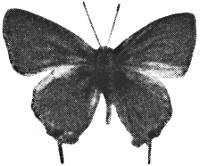
MENTOR GRAVURES
SPRING BUTTERFLIES
AMERICAN FRITILLARIES
ADMIRALS
A GROUP OF SWALLOWTAILS
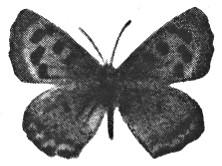
MENTOR GRAVURES
A GROUP OF VERY COMMON BUTTERFLIES
A SWALLOWTAIL AND GROUP OF SKIPPERS
By DR. W. J. HOLLAND
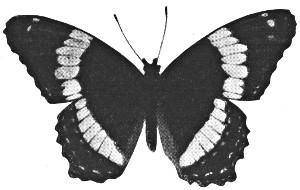
Copyright The Century Co.
NORTH AMERICAN BUTTERFLIES
Above left—Gray Hairstreak. Above right—American Copper. Center—The Banded Purple
THE MENTOR · DEPARTMENT OF NATURAL HISTORY
AUGUST 2, 1915
Entered at the postoffice of New York, N. Y., as second-class matter. Copyright, 1915, by the Mentor Association, Inc.
The earliest memories of my childhood cluster about a little manse in the countryside. In winter, when the drifts were deep and the house was snowbound, a usual recreation was to look at the cabinets containing shells collected in Jamaica by my father during his residence as a missionary on that island. I preferred, however, to feast my eyes on the contents of certain flat boxes of Jamaica cedar, in which many of the gorgeous moths and butterflies, as well as other insects, of that sunny island were displayed.

Fig. 1
MAGNIFIED SCALES OF BUTTERFLIES
1, 2, ordinary scales. 3-5, androconia, or scales from wings of male butterflies
When spring and summer came I was very busy gathering plants, pressing them for my little herbarium, and collecting shells which I found in the woodlands and when wading the streams. Among insects the beetles and butterflies pleased me most. Later my home was in North Carolina, whither the family removed from central Ohio when I was a child of ten. Here the same process went on, with the added pleasure of being near a library, in which, among other books, was a copy of Wilson and Bonaparte’s “American Ornithology,” many of the plates in which I copied, and Say’s work on “American Entomology.” The collection of plants and insects grew apace, and I was allowed to begin to stuff and mount birds.

Fig. 2
WING SCALES
Greatly magnified scales of Cabbage butterfly
In 1863 I came north, and for ten years my life was passed in college and professional schools, where I had little time to study ornithology and entomology. But the love of living things survived, and when, at last settled in active professional life, I began to feel the need of some pursuit which would furnish a physical as well as intellectual recreation, I reverted to the study of insects. This took me into the woods and fields.
Having begun to collect insects, I made up my mind that I must learn to know all about them. I sought for books on the subject. There were none of any value in the libraries about me. I then began to buy books, and have continued, until today I possess a collection of works upon entomology which is said to be the largest in private hands in America. I began to seek information from other students of the subject. The circle of my correspondence has grown until it covers many lands. One of my correspondents, the late W. H. Edwards of Coalburg, West Virginia, wrote to me that he wished to publish the third volume of his magnificent work, “The Butterflies of North America,” and therefore contemplated offering his collection to the British Museum in order to obtain the necessary funds. I replied to him that I would undertake to defray the expense of bringing out the third volume of his work, provided he would turn over the collection to me, so that it might be incorporated with my own. He accepted my offer, and I thus saved for America its most important collection of butterflies. I bought many other collections from time to time. I traveled widely, always collecting, and I employed men to collect for me in foreign lands. Today my collection is one of the largest in existence, containing tens of thousands of species and hundreds of thousands of specimens.

Fig. 3
EGG OF THE VICEROY
Basilarchia disippus
Magnified 30 diameters

Fig. 4
EGG OF THE MONARCH
Anosia plexippus
Magnified 30 diameters

Fig. 5
THE MONARCH FROM LARVÆ TO CHRYSALIS
a, before shedding skin. b, in act of shedding skin. c, trying to catch hold of silk button
To learn what I have involved a large outlay of money and much patient study. When, therefore, it was suggested to me to prepare a comprehensive book on the butterflies of the United States and Canada I resolved to undertake the task; if for no other reason, to spare the rising generation of young Americans from the expense and trouble to which I had been subjected in trying to master the subject. I resolved to illustrate the book profusely, using so far as possible the types or identical specimens on which Edwards and others had founded their descriptions. The result was “The Butterfly Book,” and I am now following that up with a small manual entitled “The Butterfly Guide.” Both of these works are illustrated with colored figures. With these books the boys and girls of America are no longer compelled to wade, as I did, through piles of books and pamphlets in order to get the information they desire.
I feel that a brief recital of the way in which I came to be a student of this delightful subject may interest others, and the story may encourage some of the bright boys of America to take up the study of entomology earnestly. It is no mean subject. There was a time when “bugologists,” as students of insect life were facetiously called, were classified as a variety of harmless cranks; but that day has passed. The discovery that some knowledge of entomology is necessary to success in agriculture, and that many diseases are due to infection brought about by insects, has led the public to recognize the value of these pursuits from a social and economic standpoint. But enough of this! Now for the butterflies!
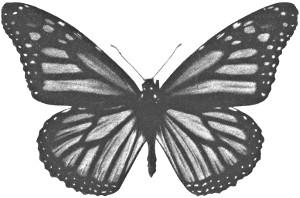
Copyright by The Century Co.
MONARCH BUTTERFLY

Fig. 6
CHRYSALIS OF THE MONARCH

Fig. 7
CHRYSALIS OF THE PIPEVINE SWALLOWTAIL
Papilio philenor
Butterflies form one of the two suborders of the order Lepidoptera, or “scaly-winged insects.” There are many orders of insects. Lord Walsingham some years ago in an address stated that there were not less than three million species of insects in this little world of ours. Tens of thousands of species of Lepidoptera have already been named and classified. Of butterflies there are twenty thousand species and varieties known, and of moths there are about five times as many. In the United States we have about six hundred and fifty species of butterflies, and six thousand species of moths. New species are still being turned up. Adam did not give names to all living things. He left his job unfinished, and “the sons of Adam” since his day have been carrying on the good work, and most vigorously during the last hundred years. The work of naming and describing species new to science is going on valorously at the present time. The last volume of “The Zoölogical Record,” which has just been issued, shows that in 1913 nearly three thousand strictly scientific books and papers about insects were published, not to speak of the innumerable publications of a popular character upon the same subject which were printed during that year. The same volume shows that no less than two hundred and twenty-five new species of butterflies alone were described during the year, besides a host of so-called varieties. The new species were principally from Africa, Asia, and South America.
As I have said, butterflies are “scaly-winged insects.” Anyone who has ever taken a moth or butterfly into his fingers has observed that the creature in its struggles leaves behind a dustlike substance. Examined under a microscope, this is seen to be composed of minute scales. Magnified forms of some of these scales are represented in Figure 1; while in Figure 2 there is shown a little patch of the scales on the wing of the common Cabbage butterfly, they being arranged somewhat as the shingles upon the roof of a house, or the scales upon the sides of a fish.

Fig. 8
CATERPILLAR OF THE MONARCH
Anosia plexippus

Fig. 9
HIBERNACULUM
The little case made by weaving the sides of a leaf together and tying it to a twig by strands of silk. In this the baby larvæ of the Viceroy passes the winter

Fig. 10
CATERPILLAR OF THE VICEROY
Fully matured
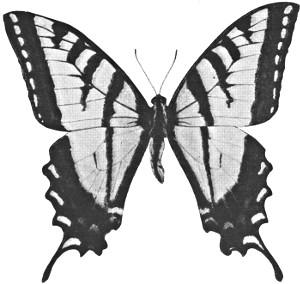
Copyright by The Century Co.
TIGER SWALLOWTAIL
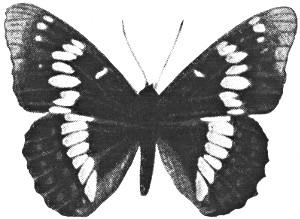
Copyright by The Century Co.
LARQUIN’S ADMIRAL
Butterflies possess a remarkably perfect organization, which includes the possession of senses and a considerable measure of intelligence, when we consider the relative lowliness of their station in the scale of being. Butterflies can see. They have, as all insects have, compound eyes, made up of a number of facets, so that they can look upward, downward, forward, and backward all at the same time. Their antennæ (or feelers, as they are sometimes erroneously called) are most probably organs for smelling. Their organs for hearing, if they have any, are located upon their legs, as they are in the grasshoppers and other insects. But butterflies do not appear to be talkative, as the grasshoppers and crickets are; though some species can make curious clicking sounds, as some moths can make squeaking sounds. That they can taste is more than likely. Connected with the proboscis of butterflies, through which they suck the honey of flowers, there are, no doubt, gustatory nerves. Their brains, if the nerve-knot in the head can be so called, are not very large; but their instincts in some respects are marvelous. What, for instance, could be more wonderful than the manner in which the female butterfly, without having received a botanical education, infallibly selects the right plant upon which to lay her eggs, so that her progeny, which she never lives to see, may obtain proper nourishment? Nobody ever saw a female Swallowtail lay her eggs upon pine or clover; nobody ever saw a Cabbage butterfly lay her eggs upon other than a cruciferous plant,—either a cabbage, or one of its cousins, as plant relationships go.
One of the most wonderful things in the world of life is the manner in which insects and butterflies, and moths in particular, undergo transformation, passing from the egg into the caterpillar, then changing into the chrysalis, and finally emerging as the winged insect, fluttering among the flowers.
The eggs of butterflies are beautiful objects when examined under a microscope. Some are shaped like spheres, some like cones, some like spindles, others like turbans. They are fluted, ribbed, pitted, sculptured, in a multitude of ways. In color they are as various as the eggs of birds. Figure 3 shows the egg of the Viceroy (Basilarchia disippus), one of the Admirals belonging to the same group of insects as those which are figured on one of the plates of “The Butterfly Book,” reproduced with this article. Figure 4 shows the egg of the Monarch, or common “Milkweed butterfly” (Anosia plexippus), which the Viceroy mimics in the color and markings of its wings.

Fig. 11
WING OF THE VICEROY
The scales removed to show the arrangement of wings

Fig. 12
FRAME OF A FOLDING BUTTERFLY NET

Fig. 13
RING FOR A BUTTERFLY NET
Made by soldering a hoop of stout brass wire into the top of the ferrule of a fishing rod

Fig. 14
JAR FOR KILLING BUTTERFLIES
A sheet of perforated paper pasted over lumps of cyanide of potash held in place at the bottom by dry sawdust
When the caterpillar within the egg has reached its full development the top of the egg splits off, as if a lid had been lifted, and the little creature crawls out, and generally makes its first meal upon the shell which it has just vacated, thus whetting its appetite for future banquets, treating the shell as a hors d’œuvre. The larvæ of most butterflies and moths feed on vegetable food; but there are some curious species, even of butterflies, which are carnivorous, the caterpillars of which devour mealy bugs and the larvæ of ants. The ant-eating species are found in Africa, Asia, and Australia.
Caterpillars have the remarkable power of producing silk. Silk is a viscous fluid secreted by long glands, which are near the back of the caterpillar, and communicate with a little, tubelike organ near the jaws, called the spinneret, through which the silk is voided, instantly becoming, on contact with the air, a tough elastic fiber. Out of the silk thus secreted the caterpillars of butterflies spin threads, which they lay along the leaves and branches to guide themselves from place to place. From the silk many species weave little shelters, or tents, in which they are protected through the cold of winter. From the same delicate material they fashion the little knobs, buttons, and girdles by which the chrysalids are supported. The larvæ of butterflies do not spin cocoons: this is done only by the caterpillars of moths.

Fig. 15
A BUTTERFLY SET AND MOUNTED FOR DRYING
Caterpillars, as they develop, shed their skins a number of times. When the little caterpillar has “grown too big for its breeches” it anchors itself by a few threads to a fixed spot, the skin splits along the back, and, being securely tied in place, remains fast, while the caterpillar crawls out of it. The larvæ begins then to feed and grow again, but often treats the shed skin as it treated the shell of the egg, using it as a sort of “first course” before resuming the more substantial vegetable diet.
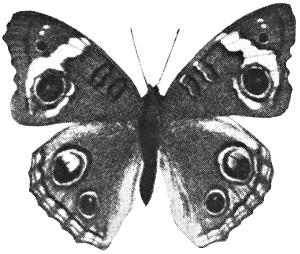
Copyright by The Century Co.
THE BUCKEYE
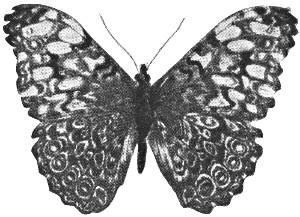
Copyright by The Century Co.
ORANGE-SKIRTED CALICO
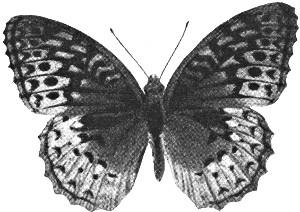
Copyright by the Century Co.
GREAT SPANGLED FRITILLARY
After the caterpillar has molted four or five times it is transformed into a chrysalis, reverting to a stationary condition, fixed as immovably as it was fixed when it was only an egg. The process of transformation is wonderful, and well repays attention. Among butterflies there are three kinds of chrysalids,—those which are pendant from a knob of silk, those which are supported by girdles as well as by a silken knob, and those which are free and lie loose between leaves and rubbish, stitched together with a few strands of silk. The chrysalids of the “brush-footed butterflies” (Nymphalidæ) are always pendant; those of the other families are cinctured, or provided with girdles, except the “skippers” (Hesperiidæ), the chrysalids of which are free, and often are found on the ground, like the chrysalids of moths.
Figure 5 shows a caterpillar of the Monarch or Milkweed butterfly undergoing the change into a chrysalis. There comes a critical moment when the creature has wriggled itself nearly out of its skin, and when the only thing to keep it hanging in its place is a fold of this skin caught, as shown at c, between two segments or rings of the abdomen. Thus suspended, it feels about with the cremaster, as the spine at the end of its tail is called, which is full of minute curved hooklets at its end. As soon as the creature feels these hooklets securely gripping into the silk of the button above, it straightens out, and lets go its hold upon the old skin and assumes the form given in Figure 6, which gives the outline of the perfect chrysalis of this species,—a truly beautiful object, pale, pearly green in color, adorned with spots of burnished gold. Figure 7 shows the cinctured chrysalis of the Pipevine Swallowtail. After sufficient time has elapsed to permit of certain developments which take place in the chrysalis, the butterfly emerges. The thing, which has slept as if in a coffin, comes forth on airy wings to disport itself among the flowers. Little wonder that poets have seen in this transformation an emblem of the Resurrection!
Some of the butterflies of the United States belong to genera which are not confined to this country, but which occur also in the Eastern Hemisphere. Indeed, some few species are identically the same as are found in Europe and Asia. The Red Admiral (Vanessa atalanta) and the Mourning Cloak (Vanessa antiopa) are as familiar to English and German schoolboys as they are to boys in America. The Painted Lady (Pyrameis cardui), known also as the Thistle butterfly, is a cosmopolitan, and occurs all over the world, except perhaps in the hot jungles of the Kongo and the Amazons. The Mourning Cloak hibernates as a butterfly. In February, 1915, one of the guards in the Carnegie Museum found a specimen of this butterfly which had flown into the building. The day had been mild, and it had ventured forth from its hiding place under the eaves, or in a hollow tree. These butterflies may be found early in spring, as soon as the sap begins to flow, congregating in the sugar camps and sipping the drip of the maple trees. Comparatively few butterflies pass the winter in the winged form, but undergo its rigors as chrysalids or as larvæ.

Fig. 16
VIVARIUM
A breeding cage in which caterpillars may be reared until the butterflies are produced
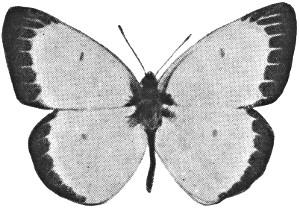
Copyright by The Century Co.
CLOUDED SULPHUR
Most of the butterflies of the United States show a relationship to those of the lands south of us. As the ice at the end of the Glacial Period retreated there was an invasion of forms from the south. The Monarch, one of our very commonest species, makes an annual migration into the northern parts of the continent, coming up from the south, as the milkweeds begin to sprout and put forth leaves, and then in autumn retreats again to “lands of sun.” The species goes far north into Canada, and in the fall of the year huge swarms of the retiring insects may be seen clustering upon trees on the northern shores of the Great Lakes, and also about Cape May in New Jersey. Many, no doubt, are drowned in the lakes and in the ocean as they try to make their way farther south.

Copyright by the Century Co.
COMMON WOOD-NYMPH
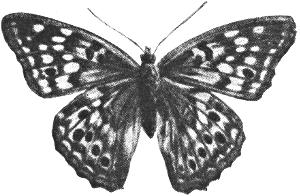
Copyright by The Century Co.
EYED EMPEROR
Among the most conspicuous and beautiful butterflies of the United States are the Swallowtails, which belong to the genus Papilio. We have many species. There are only three found in all Europe. One of these (Papilio machaon), now nearly extinct in England, surviving only in the fens of Cambridge and Norfolk, has many first cousins in North America, one of which (Papilio zelicaon) is represented on the plate entitled “A Group of Swallowtails.” The metropolis of the Machaon group of Swallowtails is North America, and species belonging to it are found from Newfoundland to Central America. I have a strong suspicion that the butterflies of this group originated in the New World, as did the horse, the camel, and many other animals, and that at a time when North America and Asia were connected with each other in the region of Bering Sea, as we know they were, this insect “went west” and finally established a colony in England, which was at about that time also hitched fast to the continent of Europe.
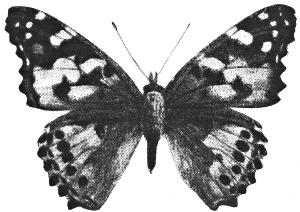
Copyright by The Century Co.
THISTLE BUTTERFLY
Another group of butterflies which are nobly represented in North America are the Fritillaries, belonging to the genera Argynnis and Brenthis. A group of these insects is shown in one of the plates. The reader will observe how great a difference there is between the males and the females, especially of Argynnis Diana. When the sexes thus differ they are said to be “sexually dimorphic.” There are other kinds of dimorphism. When butterflies have several broods it has been observed that those of the spring brood differ in form and markings from those of the summer brood, and again from those which come forth in the fall of the year. Such species are said to be “seasonally dimorphic.” In the tropics we recognize what are known as “dry season forms” and “rainy season forms,” which are often very unlike each other. Sexual dimorphism is not so pronounced in all species of the genus Argynnis as it is in A. Diana. The Fritillaries have their metropolis in North America, but are also well represented in Asia, Europe, and to some degree in Africa and in South America. In the latter continent the species occur among the cool Andean regions and in the far south, in Patagonia. It is a curious fact that on the flanks of Mounts Kenia and Kilimanjaro, in Africa, separated by thousands of miles from their congeners, there are species of this group of butterflies. How did they get there? The geologist maybe can answer.
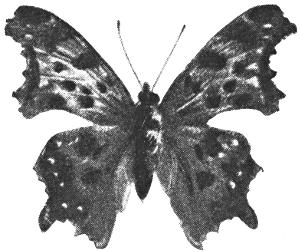
Copyright by The Century Co.
THE COMMA
America is rich in species belonging to the family of the Hesperiidæ or “Skippers.” They are well named, as anyone who has watched them skipping and gamboling among the flowers can testify. They seem to be in some respects intermediate between the other butterflies and the moths.
An adequate account of the breeding of butterflies and of the methods of preserving them for study and display would require another article. I will then, at this time, simply refer the curious to the books already written about these things, and, if any of The Mentor readers are tempted to find the secret of eternal youth, by becoming entomologists, they will discover that every library of any size has in it today copies of the books they need to guide them. That was not the case forty years ago.
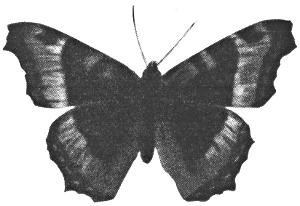
Copyright by The Century Co.
NETTLE TORTOISE SHELL
The annual loss suffered by agricultural communities through ignorance of entomological facts is very great. Every plant has its insect enemy, or, more correctly, its insect lover, which feeds upon it, delights in its luxuriance, but makes short work, it may be of leaves, it may be of flowers, it may be of fruit. It has been estimated that every known species of plant has five or six species of insects which habitually feed upon it.
We all have heard of the Hessian fly, of the weevil, and of the army-worm. The legislature of Massachusetts has in recent years been spending hundreds of thousands of dollars in the attempt to exterminate the gipsy moth. The caterpillar of the Cabbage butterfly ruins every year material enough to supply sauerkraut to half of the people. The codling moth, the little pinkish caterpillar which worms its way through apples, is estimated to destroy five millions of dollars’ worth of apples every year within the limits of the United States.
A few facts like these serve to show that the study of entomology is not a study which deserves to be placed in the category of useless pursuits. Viewed merely from a utilitarian standpoint, this study is one of the most important, far outranking, in its actual value to communities, the study of many branches of zoölogical science which some people affect to regard as of a higher order.
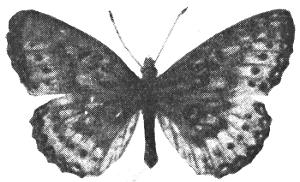
Copyright The Century Co.
SILVER-BORDERED FRITILLARY
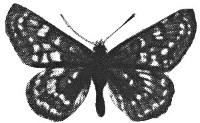
Copyright by The Century Co.
BRUER’S LEMONAIS
Reprinted, by special permission, from the Century Dictionary
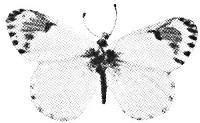
Copyright by W. J. Holland, 1898
THE PURPLISH COPPER
From “The Butterfly Book”
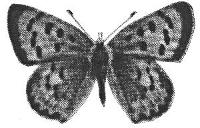
Copyright by W. J. Holland, 1898
REAKIRT’S ORANGE-TIP
From “The Butterfly Book”
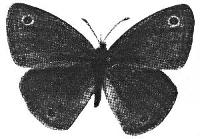
Copyright by W. J. Holland, 1898
THE RED SATYR
From “The Butterfly Book”
THE BUTTERFLIES OF NEW ENGLAND
By Samuel Hubbard Scudder.
3 vols., illustrated by numerous fine plates and maps, showing over 100 species, with countless anatomical details, etc.
THE BUTTERFLIES OF NORTH AMERICA
By William Henry Edwards.
Numerous exquisite plates, in which over 200 species are figured.
THE BUTTERFLY BOOK
By W. J. Holland.
48 colored plates, showing 525 species and varieties.
THE BUTTERFLY GUIDE
By W. J. Holland.
150 small plates, showing 255 commoner species in natural colors. (In press.)
THE BUTTERFLIES OF THE EASTERN UNITED STATES
By G. H. French.
HOW TO KNOW THE BUTTERFLIES
By John Henry and Anna Botsford Comstock.
45 colored plates, showing about 125 species.
GUIDE TO BUTTERFLIES
By Samuel Hubbard Scudder.
22 uncolored plates, showing about 100 species.
THE BUTTERFLIES OF THE WEST COAST
By W. G. Wright.
32 colored plates, with figures of 487 species.
There are no small things in Nature, whatever the text-books say. All things in life are large and important if we will but have them so. The terms “large” and “small” are simply relative. To the eye of the insect world the delicate butterfly is a monster with widespread wings that completely cover the sky. To us the butterfly is an aery trifle, a gentle, silken-winged creature, a favorite subject of the poet’s fancy, “fluttering gaily, frolicking daily”—its life all pleasure, its task all play.
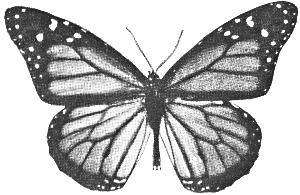
MILKWEED BUTTERFLY
Anosia plexippus, Linnæus. Body dark, border of wings black and spotted, center orange in color
And yet while so substantial and ponderous an animal as an ox can do its heavy work under a name containing but two letters, these fragile, fairy creatures must bear up under the burden of such titles as Argynnis Cybele or Lycæna Pseudargiolus. To the untutored mind it seems unfair.
But Dr. Holland tells us that we must not be daunted by this, nor let it check our interest in the study of butterflies. “The student of this delightful branch of science,” he says, “is certain to be called upon to use some rather long and uncouth words in the pursuit of the subject. But experience will soon enable him to master any little difficulties that arise from this source, and he will finally come to recognize how useful these technical terms are in designating distinctions which exist, but which are often wholly overlooked by the uneducated and unobservant.” It is reassuring, then, to be told by Dr. Holland that the collector at the outset need not tax his memory with the long scientific names which he encounters in the books. The late Dr. Horn, a most eminent entomologist, once said to Dr. Holland that he made it a duty not to try to remember the scientific names. He was content to have these names attached to the pins holding the specimens in his cabinet, where he could easily refer to them.
“In writing about butterflies,” Dr. Holland says, “it is quite customary to abbreviate the generic name by giving merely its initial. Thus, in writing about the Milkweed Butterfly, Anosia plexippus, the naturalist will designate it as A. plexippus.” Then he will attach the name of the man who gave this specific name to the insect. As Linnæus was the first to name this particular insect, the abbreviation would be as follows: A. plexippus, Linn. This simplifies things to some extent.
“In speaking about butterflies,” writes Dr. Holland, “it is quite common to omit the generic name altogether and use only the specific name. Thus, after returning from a collecting trip, I might say: ‘I was quite successful today. I took twenty Aphrodites, four Myrinas, and two specimens of Atlantis.’ In this case there can be no misunderstanding of the meaning.” The specific names alone are sufficient, and they are easy enough for any enthusiastic collector to learn.

W. D. Moffat
Editor
The Butterfly Book
Courtesy Doubleday, Page & Co.

Copyrighted by W. J. Holland, 1898
SPRING BUTTERFLIES
BUTTERFLIES
Monograph Number Six in The Mentor Reading Course
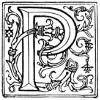
Painted Lady and Thistle Butterfly are prettier names than Pyrameis cardui for the familiar speckled, brown creature with a roseate tinge shown at the top of the plate. Found wherever the thistle grows, it is therefore one of the most widely distributed of all butterflies (as the thistle is one of the most widely distributed of all plants), fluttering over the purple blooms in the temperate regions of both hemispheres and in many tropical lands as well. It is hard to distinguish the Painted Lady from Hunter’s butterfly on the left. If, however, we should look on the under side of the hind wings, we should find that the Hunter’s butterfly has two large eyelike spots there, and the Painted Lady numerous and smaller eyelike spots. The two specimens are male.
Another common butterfly belongs to the Angle Wings, whose characteristics are deeply cut fore wings, the under side mimicking the bark of trees and dead leaves. The under side of the rover shown here visiting a dandelion is mottled brown with a pale purple hue. A silvery mark, like a semicolon or an interrogation, on the hind wings gives Grapta interrogationis its curious name. This is a common butterfly in the United States. Happy flocks are frequently found at the pans and buckets in a sugar camp, joyfully drinking the sap which drips from the wounded maples.
The splendid female spreading her lustrous velvet wings and rocking on a buttercup, on the lower right, is Vanessa antiopa, popularly known as the Mourning Cloak and the Camberwell Beauty. Though common in the north temperate zone, this splendid butterfly is none the less beautiful because it is a familiar object. The blue spots and the yellow border form a very decorative combination. The eggs of this butterfly are laid on twigs of willows and elms, upon which the caterpillars feed. The wings are noticeably graceful in line and proportion. The Painted Lady, the Hunter’s butterfly, the Interrogation butterfly, and the Mourning Cloak belong to the enormous family of the Nymphalidæ, or brush-footed butterflies.
In an entirely different family are classed the Sulphurs, belonging to the genus Colias. They are medium-seized butterflies, yellow or orange in hue, with black borders upon their wings. Though there are many varieties, ranging from the palest primrose to the deepest orange, and varying also in size as well as color, yet, in the main, the species is remarkably constant. The chief food of the Sulphurs is clover, and consequently the lovely pink and white clover fields are alive with these delicate little sprites. The Sulphurs also swarm in moist places by the wayside, and rise from pools and ruts in the roads at the approach of persons or vehicles. The butterflies in this family have six walking feet. The family, the Papilionidæ, which includes the Swallowtails and their allies, the Sulphurs and Whites, is very large.
PREPARED BY THE EDITORIAL STAFF OF THE MENTOR ASSOCIATION
ILLUSTRATION FOR THE MENTOR, VOL. 3, No. 12, SERIAL No. 88
COPYRIGHT, 1915, BY THE MENTOR ASSOCIATION, INC.
The Butterfly Book
Courtesy Doubleday, Page & Co.

Copyrighted by W. J. Holland, 1898
AMERICAN FRITILLARIES
BUTTERFLIES
Monograph Number Two in The Mentor Reading Course

The Fritillaries (taking their name from their resemblance to the spotted flowers of the lily, called fritillary), or Silver Spots, belong to the Nymphalidæ, one of the largest families of butterflies. The scientific name of the genus is Argynnis.
These Fritillaries, or Silver Spots, are of medium or large size, generally with the upper surface of the wings reddish or tawny yellow, marked with well-defined black stripes and spots like arrowheads near the outer borders. On the under side of the fore wings the design is faintly repeated; while on the under side of the hind wings large silvery spots are so numerous and characteristic that they give this tribe its popular name. The eyes are bare, the antennæ moderately long, ending in a well-defined, flattened club.
These beautiful butterflies are found all over the world; but they have reached their greatest development in North America. One cannot travel anywhere in the summer and early autumn without seeing some form of the genus.
The sexes seem to have equally divided their fine points; for the male is brighter in hue on the upper surface, while the female has the broader black markings on her paler ground color. This will be evident by looking at the plate, where the male and female of three varieties of Fritillaries appear. The two in the center are classified as Argynnis Diana. These splendid creatures, the finest of their race, are found at their best in Virginia, the Carolinas, northern Georgia, Kentucky, Tennessee, Ohio, Indiana, Missouri, and Arkansas. The male is a deep, rich brown, with a dull, orange border, ornamented with two rows of brown spots, larger on the fore than on the hind wings. The under side of the wings is pale buff, deeply marked with black on the fore wings; while the hind wings are decorated with silvery crescents on a rich, velvety, bluish black. The fore wings of the female are ornamented with three rows of bright blue spots (the outer row sometimes is pale blue or white). Blue spots edge the hind wings, the inner row somewhat squared, and each has a central spot of black. Blue and black spots mark the under side of her fore wings, and silvery crescents and spots the under side of her hind wings.
The Great Spangled Fritillary appears on the plate. Its scientific name is Argynnis cybele. It ranges over the Atlantic States and the valley of the Mississippi as far as Nebraska. A small variety is found in New Mexico. The upper surface is tawny red, with heavy and handsome stripes and spots of black. The under side is heavily silvered. The female is paler than the male and appears to wear a kind of bolero jacket of dark, chocolate brown. Her markings are heavier than those of her lord and master. On the under side she wears exactly the same silvery decorations that he sports.
Argynnis Leto is represented at the bottom of the plate, and greatly resembles the former variety. Its ground color is paler; but the female is more heavily marked, but with less silver underneath.
PREPARED BY THE EDITORIAL STAFF OF THE MENTOR ASSOCIATION
ILLUSTRATION FOR THE MENTOR, VOL. 3, No. 12, SERIAL No. 88
COPYRIGHT, 1915, BY THE MENTOR ASSOCIATION, INC.
The Butterfly Book
Courtesy Doubleday, Page & Co.

Copyrighted by W. J. Holland, 1898
ADMIRALS
BUTTERFLIES
Monograph Number Three in The Mentor Reading Course

The largest family of butterflies is called Nymphalidæ,—a pretty name; for are not these “winged flowers” nymphs and sylphs of the woods and fields?
This family is also called “Brush-footed,” because the fore legs are without tarsi, or feet, in both sexes; the first pair of legs being dwarfed, the feet looking like a brush of hairs, and so utterly useless for walking that they are carried folded up against the breast. This enormous family is divided into many subfamilies. It embraces both large and small species. The family is ancient, and most fossil butterflies so far discovered belong to it.
A widely distributed genus of this family comprises the White Admirals (Basilarchia). These are among our most interesting butterflies. Their heads are large, their antennæ moderately long, ending in a short club, their fore wings subtriangular with the tip well rounded, and the hind wings rounded and scalloped. The plate exhibits several varieties. In the lower right is Basilarchia astyanax, or the Red-spotted Purple, which ranges from southern Canada through the United States as far as the Rocky Mountains and even to Mexico. This butterfly is somewhat variable, not always keeping closely to its type.
Flying downward in the upper right and center are two forms of Basilarchia arthemis. The central butterfly is distinguished by broad white bands crossing both the fore wings and the hind wings. It is further ornamented on the hind wings by a row of red spots shading into blue and crescents following the indentations. In the form above, known as proserpina, the white bands are less marked. The main characteristic of the forms is the persistence of the red spots on the upper side of the hind wings. These butterflies abound in New England, New York, Quebec, Ontario, and parts of Pennsylvania. A close family resemblance is traced in the Basilarchia Weidenmeyeri in the upper left-hand corner. It differs by having a series of white spots on the borders of the wings.
Lorquin’s Admiral (Basilarchia Lorquini) is easily distinguished from all other species by the short yellowish bar near the middle of the fore wings and the bright red hue of the tips of these wings. A California species appears in the lower left-hand corner, handsomely banded and strikingly marked with orange-red spots near the ends of the fore wings.
PREPARED BY THE EDITORIAL STAFF OF THE MENTOR ASSOCIATION
ILLUSTRATION FOR THE MENTOR, VOL. 3, No. 12, SERIAL No. 88
COPYRIGHT, 1915, BY THE MENTOR ASSOCIATION, INC.
The Butterfly Book
Courtesy Doubleday, Page & Co.

Copyrighted by W. J. Holland, 1898
A GROUP OF SWALLOWTAILS
(The figures in this plate are reduced, being only two-thirds of the natural size)
BUTTERFLIES
Monograph Number Four in The Mentor Reading Course

Three Swallowtails appear among the apple blossoms on this plate. This group of the Papilionidæ is characterized by having a long tail at the end of each hind wing. Swallowtails are usually large, with great diversity of form in the wings. Some species mimic the Milkweed butterflies and the Heliconians, in such cases having no tails. A small matter like that does not disturb the entomologist, who has other ways of testing than diversities of color and form. He looks at the anatomy of the insect, and no amount of mimicry can save the pretender from being properly classified.
The Milkweed butterfly is particularly distasteful to birds, and therefore enjoys freedom from attack by them. Other butterflies are equally distasteful, and are therefore “protected,” as naturalists say. As the result of a slow process of development, some of the members of the Swallowtail tribe, as well as of other tribes, have come to resemble these protected butterflies, and share with them their immunity from attack. This mimicry is not conscious, nor in any sense an evidence of superior intelligence or sagacity.
The magnificent Swallowtail on the right (Papilio daunus) keeps his brilliant eyes wide open and depends upon his own rapid flight from his swift and eager pursuer rather than impair features which are as characteristic in his family as the Hapsburg lip or the Bourbon nose in those dynasties. Papilio daunus has two tails on each wing, going one better than the pride of the family, the Tiger Swallowtail, which has but one. He is doubtless very proud of the lobes of the interior angles of his hind wings. This variety is found in the eastern valleys of the Rocky Mountains, in Arizona, and in Mexico. Below is Papilio pulumnus, a little smaller than the preceding, with heavier markings and with the inner lobe of the wing so developed as to give him the appearance of having three tails. This butterfly is a Mexican, but is occasionally found in Arizona.
Flying downward is another variety, the Papilio zelicaon, whose broad black borders are decorated with white spots. It has but one tail. Its range is from Vancouver Island to Arizona and eastward to Colorado; but it prefers the valleys and foothills to the Sierras. The Swallowtails are wonderfully developed in the tropics. Many species are found in America, but only one in England. Swallowtails are great favorites with collectors. They have six walking feet in both sexes, and their flight is swift and dashing.
PREPARED BY THE EDITORIAL STAFF OF THE MENTOR ASSOCIATION
ILLUSTRATION FOR THE MENTOR, VOL. 3, No. 12, SERIAL No. 88
COPYRIGHT, 1915, BY THE MENTOR ASSOCIATION, INC.
The Butterfly Book
Courtesy Doubleday, Page & Co.

Copyrighted by W. J. Holland, 1898
A GROUP OF VERY COMMON BUTTERFLIES
BUTTERFLIES
Monograph Number One in The Mentor Reading Course

The two butterflies on the right are the male and female of the Tiger Swallowtail, the finest of this tribe. Papilio turnus is its technical name, and it abounds in Pennsylvania, Virginia, Maryland, North and South Carolina, Kentucky, and Tennessee. It is charming in its bold and rapid motions, and is a restless creature, always on the wing. Its dark bands are arranged after the fashion of a tiger’s stripes, whence its name. The Tiger Swallowtail has a tendency to produce dark forms; and the dark form of the female was long regarded as a distinct species until it was discovered that some eggs produced by yellow females produced black females, and conversely some eggs produced by black females produced yellow females.
The brilliant butterfly poised on the blades of grass on the left is the well known Red Admiral, familiar throughout North America, Europe, Asia, and Africa. It belongs to the “Brush-footed” race. Below it a little Sulphur shows the inside of its wings. This, the Colias eriphyle, extends from the Atlantic to the Pacific and from Canada to Florida and Texas.
The little brown Silver-spotted Skipper standing on the open flower, with a broad, irregular silvery spot on the under side of the hind wings, also has a wide range. It is found from Canada to the Isthmus of Panama. The Silver-spotted Skipper belongs to the Hesperiidæ, which are generally small in size, with stout bodies. They have six walking feet in both sexes, and spurs on the hind feet. The antennæ of many of these butterflies end in a fine point and are usually bent into a hook. They are noted for their quick, strong flight. When at rest most of the skippers hold their wings erect, though some of them extend them horizontally.
PREPARED BY THE EDITORIAL STAFF OF THE MENTOR ASSOCIATION
ILLUSTRATION FOR THE MENTOR, VOL. 3, No. 12, SERIAL No. 88
COPYRIGHT, 1915, BY THE MENTOR ASSOCIATION, INC.
The Butterfly Book
Courtesy Doubleday, Page & Co.

Copyrighted by W. J. Holland, 1898
A SWALLOWTAIL AND GROUP OF SKIPPERS
BUTTERFLIES
Monograph Number Five in The Mentor Reading Course
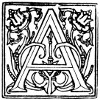
All the little brown butterflies fluttering in various positions on this plate are Skippers, members of the family of the Hesperiidæ. These are generally small and stout and have a quick, strong flight. The most striking one here is the Long-tailed Skipper, flying downward on the left. The upper side of his wings are brown, glossed with green at the base. The fore wings are spotted. This butterfly lays its eggs on the wistaria and butterfly pea. Though tropical, Eudamus protens is occasionally found along the Atlantic seacoast as far north as New York.
In the upper right-hand corner is a female Brazilian Skipper, a robust, thick-bodied butterfly common in the Gulf States and North Carolina and ranging southward through the Antilles to Argentina.
A little below is the Common Sooty Wing, black on both sides of the wings with a series of little spots. It belongs to all of North America. The New Mexican Sooty Wing is in full flight at the upper left corner. It is common in Nevada, Arizona, and New Mexico.
The brown one, the Sleepy Dusky Wing flying downward in the center and the large black one below the Common Sooty Wing belong to the genus Thanaos, the Dusky Wings, a group which reaches its largest development in North America. They are all dark; but a few varieties have bright spots on their hind wings.
Few know the one in the center, Plestea dorus, as it is confined to Arizona and Mexico. Its life history is unknown.
The brown one above the Long-tailed Skipper is called Afranius’s Dusky Wing. It is common in Arizona. The one below the Common Sooty Wing is Thanaos Clitus, having black hind wings with a broad fringe of white. Its home is Arizona and New Mexico. Nothing is known of its early stages.
The large butterfly in the lower left corner is Pyrrhopyginæ craxes, a native of southern Texas, Mexico, and farther south. Its antennæ end in curved, blunt clubs. When resting it spreads its wings horizontally. Nothing is known of its life history.
Poised on the clover a female Hoary Edge shows the under side of her wings. This belongs to the Middle and Southern States.
Flying toward the white bloom is a relative, a male Golden-banded Skipper, common in Virginia, the Carolinas, and westward to Arizona and Mexico.
Much more beautiful in form is the Swallowtail, Papilio rutulus, the Pacific Coast representative of the Tiger Swallowtail of the Atlantic States. Its ground color is a pale yellow, and it has tiger stripes like its near cousin.
PREPARED BY THE EDITORIAL STAFF OF THE MENTOR ASSOCIATION
ILLUSTRATION FOR THE MENTOR, VOL. 3, No. 12, SERIAL No. 88
COPYRIGHT, 1915, BY THE MENTOR ASSOCIATION, INC.
ESTABLISHED FOR THE DEVELOPMENT OF A POPULAR INTEREST IN ART, LITERATURE, SCIENCE, HISTORY, NATURE, AND TRAVEL
THE ADVISORY BOARD
The purpose of The Mentor Association is to give its members, in an interesting and attractive way, the information in various fields of knowledge which everybody wants to have. The information is imparted by interesting reading matter, prepared under the direction of leading authorities, and by beautiful pictures, produced by the most highly perfected modern processes.
THE MENTOR IS PUBLISHED TWICE A MONTH
SUBSCRIPTION, THREE DOLLARS A YEAR. FOREIGN POSTAGE 75 CENTS EXTRA. CANADIAN POSTAGE 50 CENTS EXTRA. SINGLE COPIES FIFTEEN CENTS. PRESIDENT AND TREASURER, R. M. DONALDSON; VICE-PRESIDENT, JOHN H. HAWLEY; SECRETARY, W. D. MOFFAT
COMPLETE YOUR MENTOR LIBRARY
Subscriptions always begin with the current issue. The following numbers of The Mentor Course, already issued, will be sent postpaid at the rate of fifteen cents each, or one dollar for eight copies.
NUMBERS TO FOLLOW
Aug. 16. THE PHILIPPINE ISLANDS
By Dean C. Worcester, Secretary of the Interior of the Philippine Islands, 1901-1913.
Everyone is interested in the Philippines and their future. Mr. Worcester has had a long experience there, and is the recognized leading authority on the subject. The illustrations have been carefully selected from a large collection in his possession.
Sept. 1. THE LOUVRE
By Prof. John C. Van Dyke
This is the beginning of a series of visits to the great art galleries of the world. In each case the members of The Mentor Association will be personally conducted by a writer of authority who is familiar with the gallery described. Naturally this will mean a number of The Mentor of great interest in text and of rare beauty in illustration.
THE MENTOR ASSOCIATION, INC.
52 EAST 19th STREET, NEW YORK, N. Y.
THE MENTOR
The Mentor Service
In addition to the interesting and instructive reading matter in the pages of The Mentor; to the beautiful gravure pictures and the many illustrations in each number; and to the graphic descriptive monographs printed with each of these gravure illustrations—in addition to all this valuable matter in text and in pictures,
THE MENTOR GIVES SERVICE
This service covers the needs of those who want to gain knowledge by an easy and agreeable method.
SUPPLEMENTARY READING COURSES. Each number of The Mentor prints a list of books for supplementary reading on the subject covered by The Mentor. But in addition to this The Mentor Service includes courses of reading for its members along the lines of subjects covered by The Mentor Course. These courses of reading are prepared under the direction of members of the Advisory Board of The Mentor—all of them prominent educators.
READING CLUB PROGRAMS. The Mentor has prepared its material in the form of courses for reading clubs. The service is complete, including not only the interesting matter supplied in The Mentor, but direction as to club organization, and programs of Mentor meetings, with practical hints concerning picture material and how to use it. These Mentor courses are so arranged as to provide for any number of club meetings, from two or three up to twenty and more.
BOOK SUPPLIES. In many cases members of the Association are not in a location convenient to sources of book supply. The Mentor Association will, therefore, secure books as requested and will supply them to its members at publishers’ prices.
INQUIRY DEPARTMENT. The Mentor gives to its members a full and intelligent service in answering inquiries concerning books, reading, and all matters of general information having a bearing on The Mentor courses. Inquiries from readers are referred to members of our Advisory Board or others who are leaders in their particular fields of knowledge.
MANY READERS HAVE COME TO KNOW THE VALUE OF THE MENTOR SERVICE. IN THE FULLEST SENSE IT SUPPLEMENTS AND ROUNDS OUT THE PLAN OF THE MENTOR. ALL MEMBERS OF THE ASSOCIATION ARE INVITED TO TAKE ADVANTAGE OF THIS SERVICE
MAKE THE SPARE
MOMENT COUNT

End of the Project Gutenberg EBook of The Mentor: Butterflies, Vol. 3, Num.
12, Serial No. 88, August 2, 1915, by W. J. Holland
*** END OF THIS PROJECT GUTENBERG EBOOK THE MENTOR: BUTTERFLIES ***
***** This file should be named 49625-h.htm or 49625-h.zip *****
This and all associated files of various formats will be found in:
http://www.gutenberg.org/4/9/6/2/49625/
Produced by Juliet Sutherland and the Online Distributed
Proofreading Team at http://www.pgdp.net
Updated editions will replace the previous one--the old editions will
be renamed.
Creating the works from print editions not protected by U.S. copyright
law means that no one owns a United States copyright in these works,
so the Foundation (and you!) can copy and distribute it in the United
States without permission and without paying copyright
royalties. Special rules, set forth in the General Terms of Use part
of this license, apply to copying and distributing Project
Gutenberg-tm electronic works to protect the PROJECT GUTENBERG-tm
concept and trademark. Project Gutenberg is a registered trademark,
and may not be used if you charge for the eBooks, unless you receive
specific permission. If you do not charge anything for copies of this
eBook, complying with the rules is very easy. You may use this eBook
for nearly any purpose such as creation of derivative works, reports,
performances and research. They may be modified and printed and given
away--you may do practically ANYTHING in the United States with eBooks
not protected by U.S. copyright law. Redistribution is subject to the
trademark license, especially commercial redistribution.
START: FULL LICENSE
THE FULL PROJECT GUTENBERG LICENSE
PLEASE READ THIS BEFORE YOU DISTRIBUTE OR USE THIS WORK
To protect the Project Gutenberg-tm mission of promoting the free
distribution of electronic works, by using or distributing this work
(or any other work associated in any way with the phrase "Project
Gutenberg"), you agree to comply with all the terms of the Full
Project Gutenberg-tm License available with this file or online at
www.gutenberg.org/license.
Section 1. General Terms of Use and Redistributing Project
Gutenberg-tm electronic works
1.A. By reading or using any part of this Project Gutenberg-tm
electronic work, you indicate that you have read, understand, agree to
and accept all the terms of this license and intellectual property
(trademark/copyright) agreement. If you do not agree to abide by all
the terms of this agreement, you must cease using and return or
destroy all copies of Project Gutenberg-tm electronic works in your
possession. If you paid a fee for obtaining a copy of or access to a
Project Gutenberg-tm electronic work and you do not agree to be bound
by the terms of this agreement, you may obtain a refund from the
person or entity to whom you paid the fee as set forth in paragraph
1.E.8.
1.B. "Project Gutenberg" is a registered trademark. It may only be
used on or associated in any way with an electronic work by people who
agree to be bound by the terms of this agreement. There are a few
things that you can do with most Project Gutenberg-tm electronic works
even without complying with the full terms of this agreement. See
paragraph 1.C below. There are a lot of things you can do with Project
Gutenberg-tm electronic works if you follow the terms of this
agreement and help preserve free future access to Project Gutenberg-tm
electronic works. See paragraph 1.E below.
1.C. The Project Gutenberg Literary Archive Foundation ("the
Foundation" or PGLAF), owns a compilation copyright in the collection
of Project Gutenberg-tm electronic works. Nearly all the individual
works in the collection are in the public domain in the United
States. If an individual work is unprotected by copyright law in the
United States and you are located in the United States, we do not
claim a right to prevent you from copying, distributing, performing,
displaying or creating derivative works based on the work as long as
all references to Project Gutenberg are removed. Of course, we hope
that you will support the Project Gutenberg-tm mission of promoting
free access to electronic works by freely sharing Project Gutenberg-tm
works in compliance with the terms of this agreement for keeping the
Project Gutenberg-tm name associated with the work. You can easily
comply with the terms of this agreement by keeping this work in the
same format with its attached full Project Gutenberg-tm License when
you share it without charge with others.
1.D. The copyright laws of the place where you are located also govern
what you can do with this work. Copyright laws in most countries are
in a constant state of change. If you are outside the United States,
check the laws of your country in addition to the terms of this
agreement before downloading, copying, displaying, performing,
distributing or creating derivative works based on this work or any
other Project Gutenberg-tm work. The Foundation makes no
representations concerning the copyright status of any work in any
country outside the United States.
1.E. Unless you have removed all references to Project Gutenberg:
1.E.1. The following sentence, with active links to, or other
immediate access to, the full Project Gutenberg-tm License must appear
prominently whenever any copy of a Project Gutenberg-tm work (any work
on which the phrase "Project Gutenberg" appears, or with which the
phrase "Project Gutenberg" is associated) is accessed, displayed,
performed, viewed, copied or distributed:
This eBook is for the use of anyone anywhere in the United States and
most other parts of the world at no cost and with almost no
restrictions whatsoever. You may copy it, give it away or re-use it
under the terms of the Project Gutenberg License included with this
eBook or online at www.gutenberg.org. If you are not located in the
United States, you'll have to check the laws of the country where you
are located before using this ebook.
1.E.2. If an individual Project Gutenberg-tm electronic work is
derived from texts not protected by U.S. copyright law (does not
contain a notice indicating that it is posted with permission of the
copyright holder), the work can be copied and distributed to anyone in
the United States without paying any fees or charges. If you are
redistributing or providing access to a work with the phrase "Project
Gutenberg" associated with or appearing on the work, you must comply
either with the requirements of paragraphs 1.E.1 through 1.E.7 or
obtain permission for the use of the work and the Project Gutenberg-tm
trademark as set forth in paragraphs 1.E.8 or 1.E.9.
1.E.3. If an individual Project Gutenberg-tm electronic work is posted
with the permission of the copyright holder, your use and distribution
must comply with both paragraphs 1.E.1 through 1.E.7 and any
additional terms imposed by the copyright holder. Additional terms
will be linked to the Project Gutenberg-tm License for all works
posted with the permission of the copyright holder found at the
beginning of this work.
1.E.4. Do not unlink or detach or remove the full Project Gutenberg-tm
License terms from this work, or any files containing a part of this
work or any other work associated with Project Gutenberg-tm.
1.E.5. Do not copy, display, perform, distribute or redistribute this
electronic work, or any part of this electronic work, without
prominently displaying the sentence set forth in paragraph 1.E.1 with
active links or immediate access to the full terms of the Project
Gutenberg-tm License.
1.E.6. You may convert to and distribute this work in any binary,
compressed, marked up, nonproprietary or proprietary form, including
any word processing or hypertext form. However, if you provide access
to or distribute copies of a Project Gutenberg-tm work in a format
other than "Plain Vanilla ASCII" or other format used in the official
version posted on the official Project Gutenberg-tm web site
(www.gutenberg.org), you must, at no additional cost, fee or expense
to the user, provide a copy, a means of exporting a copy, or a means
of obtaining a copy upon request, of the work in its original "Plain
Vanilla ASCII" or other form. Any alternate format must include the
full Project Gutenberg-tm License as specified in paragraph 1.E.1.
1.E.7. Do not charge a fee for access to, viewing, displaying,
performing, copying or distributing any Project Gutenberg-tm works
unless you comply with paragraph 1.E.8 or 1.E.9.
1.E.8. You may charge a reasonable fee for copies of or providing
access to or distributing Project Gutenberg-tm electronic works
provided that
* You pay a royalty fee of 20% of the gross profits you derive from
the use of Project Gutenberg-tm works calculated using the method
you already use to calculate your applicable taxes. The fee is owed
to the owner of the Project Gutenberg-tm trademark, but he has
agreed to donate royalties under this paragraph to the Project
Gutenberg Literary Archive Foundation. Royalty payments must be paid
within 60 days following each date on which you prepare (or are
legally required to prepare) your periodic tax returns. Royalty
payments should be clearly marked as such and sent to the Project
Gutenberg Literary Archive Foundation at the address specified in
Section 4, "Information about donations to the Project Gutenberg
Literary Archive Foundation."
* You provide a full refund of any money paid by a user who notifies
you in writing (or by e-mail) within 30 days of receipt that s/he
does not agree to the terms of the full Project Gutenberg-tm
License. You must require such a user to return or destroy all
copies of the works possessed in a physical medium and discontinue
all use of and all access to other copies of Project Gutenberg-tm
works.
* You provide, in accordance with paragraph 1.F.3, a full refund of
any money paid for a work or a replacement copy, if a defect in the
electronic work is discovered and reported to you within 90 days of
receipt of the work.
* You comply with all other terms of this agreement for free
distribution of Project Gutenberg-tm works.
1.E.9. If you wish to charge a fee or distribute a Project
Gutenberg-tm electronic work or group of works on different terms than
are set forth in this agreement, you must obtain permission in writing
from both the Project Gutenberg Literary Archive Foundation and The
Project Gutenberg Trademark LLC, the owner of the Project Gutenberg-tm
trademark. Contact the Foundation as set forth in Section 3 below.
1.F.
1.F.1. Project Gutenberg volunteers and employees expend considerable
effort to identify, do copyright research on, transcribe and proofread
works not protected by U.S. copyright law in creating the Project
Gutenberg-tm collection. Despite these efforts, Project Gutenberg-tm
electronic works, and the medium on which they may be stored, may
contain "Defects," such as, but not limited to, incomplete, inaccurate
or corrupt data, transcription errors, a copyright or other
intellectual property infringement, a defective or damaged disk or
other medium, a computer virus, or computer codes that damage or
cannot be read by your equipment.
1.F.2. LIMITED WARRANTY, DISCLAIMER OF DAMAGES - Except for the "Right
of Replacement or Refund" described in paragraph 1.F.3, the Project
Gutenberg Literary Archive Foundation, the owner of the Project
Gutenberg-tm trademark, and any other party distributing a Project
Gutenberg-tm electronic work under this agreement, disclaim all
liability to you for damages, costs and expenses, including legal
fees. YOU AGREE THAT YOU HAVE NO REMEDIES FOR NEGLIGENCE, STRICT
LIABILITY, BREACH OF WARRANTY OR BREACH OF CONTRACT EXCEPT THOSE
PROVIDED IN PARAGRAPH 1.F.3. YOU AGREE THAT THE FOUNDATION, THE
TRADEMARK OWNER, AND ANY DISTRIBUTOR UNDER THIS AGREEMENT WILL NOT BE
LIABLE TO YOU FOR ACTUAL, DIRECT, INDIRECT, CONSEQUENTIAL, PUNITIVE OR
INCIDENTAL DAMAGES EVEN IF YOU GIVE NOTICE OF THE POSSIBILITY OF SUCH
DAMAGE.
1.F.3. LIMITED RIGHT OF REPLACEMENT OR REFUND - If you discover a
defect in this electronic work within 90 days of receiving it, you can
receive a refund of the money (if any) you paid for it by sending a
written explanation to the person you received the work from. If you
received the work on a physical medium, you must return the medium
with your written explanation. The person or entity that provided you
with the defective work may elect to provide a replacement copy in
lieu of a refund. If you received the work electronically, the person
or entity providing it to you may choose to give you a second
opportunity to receive the work electronically in lieu of a refund. If
the second copy is also defective, you may demand a refund in writing
without further opportunities to fix the problem.
1.F.4. Except for the limited right of replacement or refund set forth
in paragraph 1.F.3, this work is provided to you 'AS-IS', WITH NO
OTHER WARRANTIES OF ANY KIND, EXPRESS OR IMPLIED, INCLUDING BUT NOT
LIMITED TO WARRANTIES OF MERCHANTABILITY OR FITNESS FOR ANY PURPOSE.
1.F.5. Some states do not allow disclaimers of certain implied
warranties or the exclusion or limitation of certain types of
damages. If any disclaimer or limitation set forth in this agreement
violates the law of the state applicable to this agreement, the
agreement shall be interpreted to make the maximum disclaimer or
limitation permitted by the applicable state law. The invalidity or
unenforceability of any provision of this agreement shall not void the
remaining provisions.
1.F.6. INDEMNITY - You agree to indemnify and hold the Foundation, the
trademark owner, any agent or employee of the Foundation, anyone
providing copies of Project Gutenberg-tm electronic works in
accordance with this agreement, and any volunteers associated with the
production, promotion and distribution of Project Gutenberg-tm
electronic works, harmless from all liability, costs and expenses,
including legal fees, that arise directly or indirectly from any of
the following which you do or cause to occur: (a) distribution of this
or any Project Gutenberg-tm work, (b) alteration, modification, or
additions or deletions to any Project Gutenberg-tm work, and (c) any
Defect you cause.
Section 2. Information about the Mission of Project Gutenberg-tm
Project Gutenberg-tm is synonymous with the free distribution of
electronic works in formats readable by the widest variety of
computers including obsolete, old, middle-aged and new computers. It
exists because of the efforts of hundreds of volunteers and donations
from people in all walks of life.
Volunteers and financial support to provide volunteers with the
assistance they need are critical to reaching Project Gutenberg-tm's
goals and ensuring that the Project Gutenberg-tm collection will
remain freely available for generations to come. In 2001, the Project
Gutenberg Literary Archive Foundation was created to provide a secure
and permanent future for Project Gutenberg-tm and future
generations. To learn more about the Project Gutenberg Literary
Archive Foundation and how your efforts and donations can help, see
Sections 3 and 4 and the Foundation information page at
www.gutenberg.org Section 3. Information about the Project Gutenberg
Literary Archive Foundation
The Project Gutenberg Literary Archive Foundation is a non profit
501(c)(3) educational corporation organized under the laws of the
state of Mississippi and granted tax exempt status by the Internal
Revenue Service. The Foundation's EIN or federal tax identification
number is 64-6221541. Contributions to the Project Gutenberg Literary
Archive Foundation are tax deductible to the full extent permitted by
U.S. federal laws and your state's laws.
The Foundation's principal office is in Fairbanks, Alaska, with the
mailing address: PO Box 750175, Fairbanks, AK 99775, but its
volunteers and employees are scattered throughout numerous
locations. Its business office is located at 809 North 1500 West, Salt
Lake City, UT 84116, (801) 596-1887. Email contact links and up to
date contact information can be found at the Foundation's web site and
official page at www.gutenberg.org/contact
For additional contact information:
Dr. Gregory B. Newby
Chief Executive and Director
gbnewby@pglaf.org
Section 4. Information about Donations to the Project Gutenberg
Literary Archive Foundation
Project Gutenberg-tm depends upon and cannot survive without wide
spread public support and donations to carry out its mission of
increasing the number of public domain and licensed works that can be
freely distributed in machine readable form accessible by the widest
array of equipment including outdated equipment. Many small donations
($1 to $5,000) are particularly important to maintaining tax exempt
status with the IRS.
The Foundation is committed to complying with the laws regulating
charities and charitable donations in all 50 states of the United
States. Compliance requirements are not uniform and it takes a
considerable effort, much paperwork and many fees to meet and keep up
with these requirements. We do not solicit donations in locations
where we have not received written confirmation of compliance. To SEND
DONATIONS or determine the status of compliance for any particular
state visit www.gutenberg.org/donate
While we cannot and do not solicit contributions from states where we
have not met the solicitation requirements, we know of no prohibition
against accepting unsolicited donations from donors in such states who
approach us with offers to donate.
International donations are gratefully accepted, but we cannot make
any statements concerning tax treatment of donations received from
outside the United States. U.S. laws alone swamp our small staff.
Please check the Project Gutenberg Web pages for current donation
methods and addresses. Donations are accepted in a number of other
ways including checks, online payments and credit card donations. To
donate, please visit: www.gutenberg.org/donate
Section 5. General Information About Project Gutenberg-tm electronic works.
Professor Michael S. Hart was the originator of the Project
Gutenberg-tm concept of a library of electronic works that could be
freely shared with anyone. For forty years, he produced and
distributed Project Gutenberg-tm eBooks with only a loose network of
volunteer support.
Project Gutenberg-tm eBooks are often created from several printed
editions, all of which are confirmed as not protected by copyright in
the U.S. unless a copyright notice is included. Thus, we do not
necessarily keep eBooks in compliance with any particular paper
edition.
Most people start at our Web site which has the main PG search
facility: www.gutenberg.org
This Web site includes information about Project Gutenberg-tm,
including how to make donations to the Project Gutenberg Literary
Archive Foundation, how to help produce our new eBooks, and how to
subscribe to our email newsletter to hear about new eBooks.